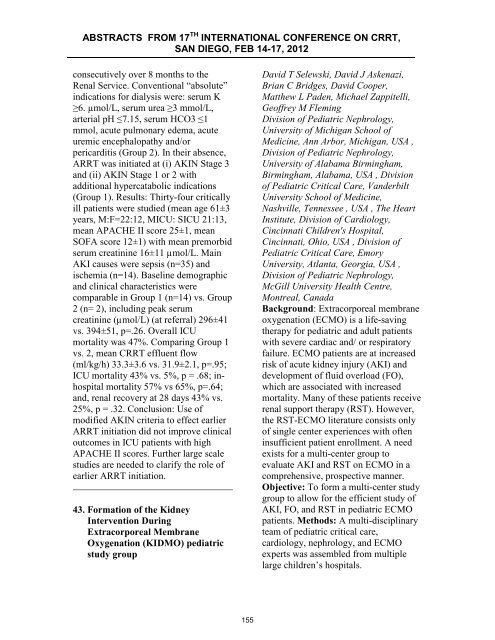ABSTRACTS from 16th International COnference on ... - CRRT Online
ABSTRACTS from 16th International COnference on ... - CRRT Online
ABSTRACTS from 16th International COnference on ... - CRRT Online
Create successful ePaper yourself
Turn your PDF publications into a flip-book with our unique Google optimized e-Paper software.
<str<strong>on</strong>g>ABSTRACTS</str<strong>on</strong>g> FROM 17 TH INTERNATIONAL CONFERENCE ON <strong>CRRT</strong>,<br />
SAN DIEGO, FEB 14-17, 2012<br />
c<strong>on</strong>secutively over 8 m<strong>on</strong>ths to the<br />
Renal Service. C<strong>on</strong>venti<strong>on</strong>al “absolute”<br />
indicati<strong>on</strong>s for dialysis were: serum K<br />
≥6. µmol/L, serum urea ≥3 mmol/L,<br />
arterial pH ≤7.15, serum HCO3 ≤1<br />
mmol, acute pulm<strong>on</strong>ary edema, acute<br />
uremic encephalopathy and/or<br />
pericarditis (Group 2). In their absence,<br />
ARRT was initiated at (i) AKIN Stage 3<br />
and (ii) AKIN Stage 1 or 2 with<br />
additi<strong>on</strong>al hypercatabolic indicati<strong>on</strong>s<br />
(Group 1). Results: Thirty-four critically<br />
ill patients were studied (mean age 61±3<br />
years, M:F=22:12, MICU: SICU 21:13,<br />
mean APACHE II score 25±1, mean<br />
SOFA score 12±1) with mean premorbid<br />
serum creatinine 16±11 µmol/L. Main<br />
AKI causes were sepsis (n=35) and<br />
ischemia (n=14). Baseline demographic<br />
and clinical characteristics were<br />
comparable in Group 1 (n=14) vs. Group<br />
2 (n= 2), including peak serum<br />
creatinine (µmol/L) (at referral) 296±41<br />
vs. 394±51, p=.26. Overall ICU<br />
mortality was 47%. Comparing Group 1<br />
vs. 2, mean <strong>CRRT</strong> effluent flow<br />
(ml/kg/h) 33.3±3.6 vs. 31.9±2.1, p=.95;<br />
ICU mortality 43% vs. 5%, p = .68; inhospital<br />
mortality 57% vs 65%, p=.64;<br />
and, renal recovery at 28 days 43% vs.<br />
25%, p = .32. C<strong>on</strong>clusi<strong>on</strong>: Use of<br />
modified AKIN criteria to effect earlier<br />
ARRT initiati<strong>on</strong> did not improve clinical<br />
outcomes in ICU patients with high<br />
APACHE II scores. Further large scale<br />
studies are needed to clarify the role of<br />
earlier ARRT initiati<strong>on</strong>.<br />
43. Formati<strong>on</strong> of the Kidney<br />
Interventi<strong>on</strong> During<br />
Extracorporeal Membrane<br />
Oxygenati<strong>on</strong> (KIDMO) pediatric<br />
study group<br />
David T Selewski, David J Askenazi,<br />
Brian C Bridges, David Cooper,<br />
Matthew L Paden, Michael Zappitelli,<br />
Geoffrey M Fleming<br />
Divisi<strong>on</strong> of Pediatric Nephrology,<br />
University of Michigan School of<br />
Medicine, Ann Arbor, Michigan, USA ,<br />
Divisi<strong>on</strong> of Pediatric Nephrology,<br />
University of Alabama Birmingham,<br />
Birmingham, Alabama, USA , Divisi<strong>on</strong><br />
of Pediatric Critical Care, Vanderbilt<br />
University School of Medicine,<br />
Nashville, Tennessee , USA , The Heart<br />
Institute, Divisi<strong>on</strong> of Cardiology,<br />
Cincinnati Children's Hospital,<br />
Cincinnati, Ohio, USA , Divisi<strong>on</strong> of<br />
Pediatric Critical Care, Emory<br />
University, Atlanta, Georgia, USA ,<br />
Divisi<strong>on</strong> of Pediatric Nephrology,<br />
McGill University Health Centre,<br />
M<strong>on</strong>treal, Canada<br />
Background: Extracorporeal membrane<br />
oxygenati<strong>on</strong> (ECMO) is a life-saving<br />
therapy for pediatric and adult patients<br />
with severe cardiac and/ or respiratory<br />
failure. ECMO patients are at increased<br />
risk of acute kidney injury (AKI) and<br />
development of fluid overload (FO),<br />
which are associated with increased<br />
mortality. Many of these patients receive<br />
renal support therapy (RST). However,<br />
the RST-ECMO literature c<strong>on</strong>sists <strong>on</strong>ly<br />
of single center experiences with often<br />
insufficient patient enrollment. A need<br />
exists for a multi-center group to<br />
evaluate AKI and RST <strong>on</strong> ECMO in a<br />
comprehensive, prospective manner.<br />
Objective: To form a multi-center study<br />
group to allow for the efficient study of<br />
AKI, FO, and RST in pediatric ECMO<br />
patients. Methods: A multi-disciplinary<br />
team of pediatric critical care,<br />
cardiology, nephrology, and ECMO<br />
experts was assembled <str<strong>on</strong>g>from</str<strong>on</strong>g> multiple<br />
large children’s hospitals.<br />
155
















